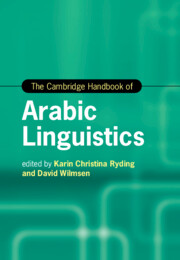Book contents
- The Cambridge Handbook of Arabic Linguistics
- Cambridge Handbooks in Language and Linguistics
- The Cambridge Handbook of Arabic Linguistics
- Copyright page
- Contents
- Figures
- Tables
- Notes on Contributors
- Acknowledgements
- Abbreviations
- Introduction
- Part I Arabic Applied Linguistics
- Part II Arabic Variation and Sociolinguistics
- Part III Theoretical and Descriptive Studies
- 12 Grammaticalization in Arabic
- 13 Arabic and Onomastics
- 14 The Intonation of Arabic
- 15 Case in Arabic
- 16 On Arabic Morphosyntax and Its Implications for the Theory of Generative Grammar
- 17 Arabic Morphology
- Part IV Arabic Computational and Corpus Linguistics
- Part V Arabic Linguistics and New Media Studies
- Part VI Arabic Linguistics in Literature and Translation
- Index
- References
15 - Case in Arabic
from Part III - Theoretical and Descriptive Studies
Published online by Cambridge University Press: 23 September 2021
- The Cambridge Handbook of Arabic Linguistics
- Cambridge Handbooks in Language and Linguistics
- The Cambridge Handbook of Arabic Linguistics
- Copyright page
- Contents
- Figures
- Tables
- Notes on Contributors
- Acknowledgements
- Abbreviations
- Introduction
- Part I Arabic Applied Linguistics
- Part II Arabic Variation and Sociolinguistics
- Part III Theoretical and Descriptive Studies
- 12 Grammaticalization in Arabic
- 13 Arabic and Onomastics
- 14 The Intonation of Arabic
- 15 Case in Arabic
- 16 On Arabic Morphosyntax and Its Implications for the Theory of Generative Grammar
- 17 Arabic Morphology
- Part IV Arabic Computational and Corpus Linguistics
- Part V Arabic Linguistics and New Media Studies
- Part VI Arabic Linguistics in Literature and Translation
- Index
- References
Summary
This chapter provides an overview of case morphology in Arabic starting with a discussion of the place of case in Arabic linguistic analysis and its historical basis. Ryding then proceeds to discuss contemporary case theory, valence theory, the lexicalist hypothesis, and case hierarchy theory as they apply to Arabic. She provides an overview of Arabic case morphology and examples of Arabic declensions before describing and analysing each of the three Arabic cases: nominative, genitive, and accusative, including a discussion of accusative/genitive syncretism and peripheral case categories such as the vocative.
- Type
- Chapter
- Information
- The Cambridge Handbook of Arabic Linguistics , pp. 353 - 370Publisher: Cambridge University PressPrint publication year: 2021



